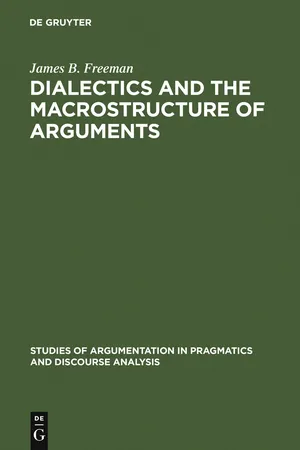
This is a test
- 287 pages
- English
- PDF
- Available on iOS & Android
eBook - PDF
Dialectics and the Macrostructure of Arguments
Book details
Table of contents
Citations
Frequently asked questions
At the moment all of our mobile-responsive ePub books are available to download via the app. Most of our PDFs are also available to download and we're working on making the final remaining ones downloadable now. Learn more here.
Both plans give you full access to the library and all of Perlego’s features. The only differences are the price and subscription period: With the annual plan you’ll save around 30% compared to 12 months on the monthly plan.
We are an online textbook subscription service, where you can get access to an entire online library for less than the price of a single book per month. With over 1 million books across 1000+ topics, we’ve got you covered! Learn more here.
Look out for the read-aloud symbol on your next book to see if you can listen to it. The read-aloud tool reads text aloud for you, highlighting the text as it is being read. You can pause it, speed it up and slow it down. Learn more here.
Yes, you can access Dialectics and the Macrostructure of Arguments by James B. Freeman in PDF and/or ePUB format, as well as other popular books in Philosophy & Philosophy History & Theory. We have over one million books available in our catalogue for you to explore.
Information
Table of contents
- Preface
- Chapter 1 The Need for a Theory of Argument Structure
- 1.1. The Standard Approach
- 1.2. Toulmin’s Rival Account
- 1.3. Problems for a Theory of Argument Structure
- 1.4. Further Problems Posed by the Standard Approach
- Chapter 2 Basic Theoretical Considerations
- 2.1. The Dialectical Nature of Argument
- 2.2. Desiderata for Theory and Practice
- 2.3. The Central Questions in a Basic Dialectical Situation
- Chapter 3 What Are the Basic Elements of Arguments?
- 3.1. Claims Versus Conclusions
- 3.2. Toulmin’s Problematic Notion of Warrant
- 3.3. Data, Warrant, Backing or Just Plain Premises?
- Chapter 4 How Do the Basic Elements Fit Together?
- 4.1. The Acceptability Question and Serial Structure
- 4.2. The Relevance Question and Linked Structure
- 4.3. The First Ground Adequacy Question and Convergent Structure
- 4.4. The Linked-Convergent Distinction
- Chapter 5 What Should We Do With Modalities?
- 5.1. Modalities – What Are They?
- 5.2. How Do Modalities Fit into Arguments?
- Chapter 6 Rebuttals – What is Their Place in Argumentation?
- 6.1. Introduction
- 6.2. Are Rebuttals Separable Elements in Arguments?
- 6.3. Are Only Exceptional Conditions Rebuttals?
- 6.4. How Do We Represent Rebuttals Diagrammatically?
- 6.5. Implication of Rebuttals for The Linked-Convergent Distinction
- 6.6. Counterrebuttals
- 6.7. Comparison with Other Authors
- Chapter 7 Further Considerations on Argument Structure
- 7.1. Mixed Structure
- 7.2. Rebuttals to Claims
- 7.3. Arguments Countering Defended Rebuttals
- 7.4. Refutations by Logical Analogy
- 7.5. Arguments Involving Suppositions
- Chapter 8 Adequacy Considerations
- 8.1. Individuation of Arguments
- 8.2. Satisfaction of Desiderata
- Conclusion. Dialectics, Macrostructure, and the Logical Enterprise
- Appendix. Two Variations on the Standard Approach to Diagramming Arguments
- Bibliography
- Index